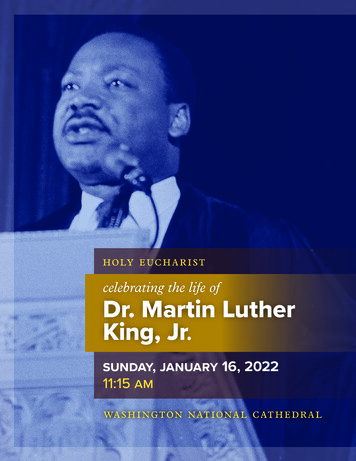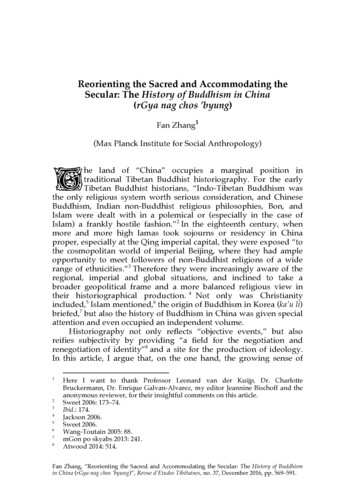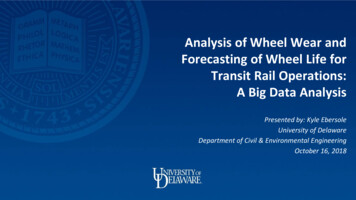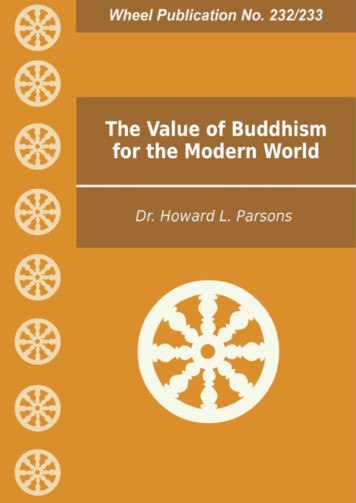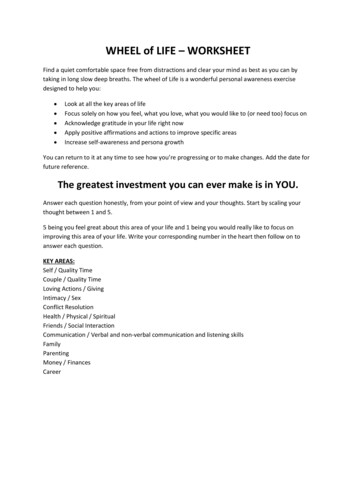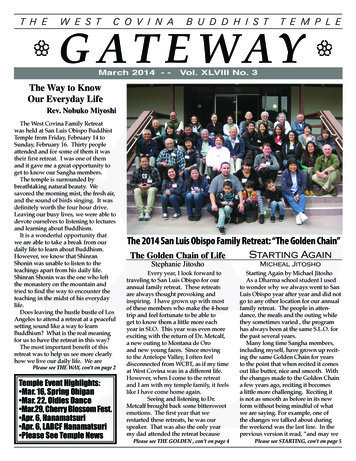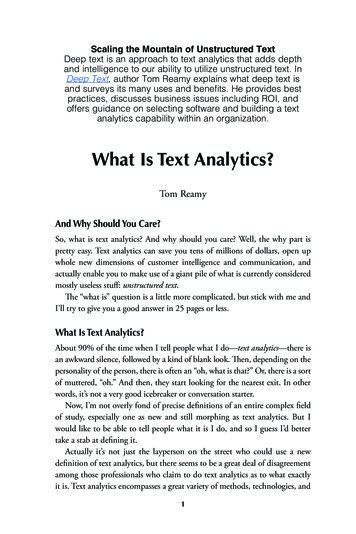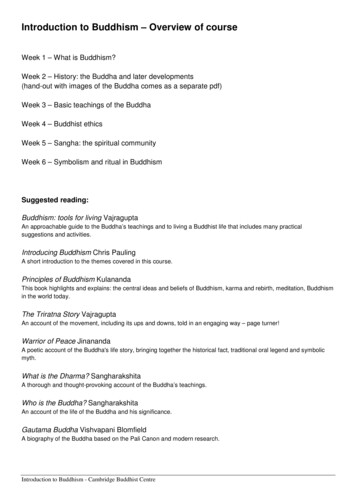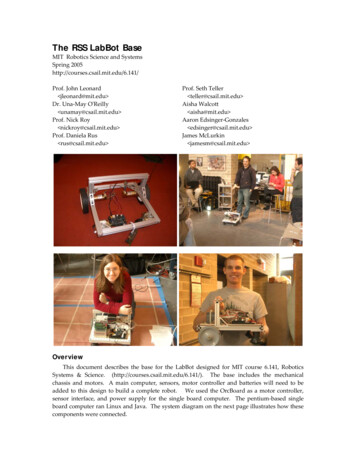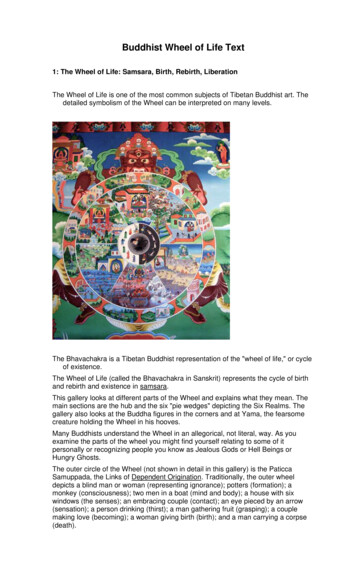
Transcription
Buddhist Wheel of Life Text1: The Wheel of Life: Samsara, Birth, Rebirth, LiberationThe Wheel of Life is one of the most common subjects of Tibetan Buddhist art. Thedetailed symbolism of the Wheel can be interpreted on many levels.The Bhavachakra is a Tibetan Buddhist representation of the "wheel of life," or cycleof existence.The Wheel of Life (called the Bhavachakra in Sanskrit) represents the cycle of birthand rebirth and existence in samsara.This gallery looks at different parts of the Wheel and explains what they mean. Themain sections are the hub and the six "pie wedges" depicting the Six Realms. Thegallery also looks at the Buddha figures in the corners and at Yama, the fearsomecreature holding the Wheel in his hooves.Many Buddhists understand the Wheel in an allegorical, not literal, way. As youexamine the parts of the wheel you might find yourself relating to some of itpersonally or recognizing people you know as Jealous Gods or Hell Beings orHungry Ghosts.The outer circle of the Wheel (not shown in detail in this gallery) is the PaticcaSamuppada, the Links of Dependent Origination. Traditionally, the outer wheeldepicts a blind man or woman (representing ignorance); potters (formation); amonkey (consciousness); two men in a boat (mind and body); a house with sixwindows (the senses); an embracing couple (contact); an eye pieced by an arrow(sensation); a person drinking (thirst); a man gathering fruit (grasping); a couplemaking love (becoming); a woman giving birth (birth); and a man carrying a corpse(death).
2: The Wheel of Life: Yama, Lord of the Underworld: The Wrathful Dharmapalaof HellThe creature holding the Wheel of Life in his hooves is Yama, the wrathfuldharmapala who is Lord of the Hell Realm.Yama, Lord of the Underworld, represents death and holds the wheel in his hooves.The terrible face of Yama, who represents death, peers over the top of the Wheel. Inspite of his appearance, Yama is not evil. He is a wrathful dharmapala, a creaturedevoted to protecting Buddhism and Buddhists. Although we may be frightened ofdeath, it is not evil; just inevitable.In legend, Yama was a holy man who believed he would realize enlightenment if hemeditated in a cave for 50 years. In the 11th month of the 49th year, robbers enteredthe cave with a stolen bull and cut off the bull's head. When they realized the holyman had seen them, the robbers cut off his head also.But the holy man put on the bull's head and assumed the terrible form of Yama. Hekilled the robbers, drank their blood, and threatened all of Tibet. He could not bestopped until Manjushri, Bodhisattva of Wisdom, manifested as the even moreterrible dharmapala Yamantaka and defeated Yama. Yama then became a protectorof Buddhism.
3: The Wheel of Life: The Realm of the Gods: Being a God Isn't PerfectThe Realm of the Gods (Devas) is the highest realm of the Wheel of Life and isalways depicted at the top of the Wheel.The Realm of the Gods of the Bhavachakra.The Realm of the Gods (Devas) sounds like a nice place to live. And, no question,you can do a lot worse. But even the Realm of the Gods isn't perfect. Those born inthe God Realm live long and pleasure-filled lives. They have wealth and power andhappiness. So what's the catch?The catch is that because the Devas have such rich and happy lives they don'trecognize the truth of suffering. Their happiness is, in a way, a curse, because theyhave no motivation to seek liberation from the Wheel. Eventually their happy livesend, and they must face rebirth in another, less happy, realm.The Devas are perpetually at war with their neighbors on the Wheel, the Asuras.This depiction of the Wheel shows the Devas charging the Asuras.
4: The Wheel of Life: The Realm of Asuras: Jealous Gods and ParanoiaThe Asura (Jealous God) Realm is marked by paranoia.The Realm of Asuras, also called Jealous Gods or Titans.Asuras are hyper-competitive and paranoid. They are driven by a desire to beat theircompetition, and everyone is competition. They have power and resources andsometimes accomplish good things with them. But, always, their first priority isgetting to the top. I think of powerful politicians or corporate leaders when I think ofAsuras.Chih-i (538-597), a patriarch of the T'ien-t'ai school, described the Asura this way:"Always desiring to be superior to others, having no patience for inferiors andbelittling strangers; like a hawk, flying high above and looking down on others, andyet outwardly displaying justice, worship, wisdom, and faith -- this is raising up thelowest order of good and walking the way of the Asuras."Asuras, who are also called "anti-gods," are perpetually at war with the Devas of theGod Realm. Auras think they belong in the God Realm and fight to get in, althoughhere it seems the Asuras have formed a line of defense and are fighting theattacking Devas with bows and arrows. Some depictions of the Wheel of Lifecombine the Asura and God realms into one.Sometimes there is a beautiful tree growing between the two realms, with its rootsand trunk in the Asura Realm. But its branches and fruit are in the God Realm.
5: The Wheel of Life: The Realm of Hungry Ghosts: Craving That Can Never BeSatisfiedHungry Ghosts have huge, empty stomachs, but their thin necks don't allownourishment to pass. Food turns to fire and ash in their mouths.The Realm of Hungry GhostsHungry Ghosts (Pretas) are pitable things. They are wasted creatures with huge,empty stomachs. Their necks are too thin to allow food to pass. So, they areconstantly hungry.Greed and jealousy lead to rebirth as a Hungry Ghost. The Hungry Ghost Realmoften, but not always, is depicted between the Asura Realm and the Hell Realm. It isthought the karma of their lives was not quite bad enough for a rebirth in the HellRealm but not good enough for the Asura Realm.Psychologically, Hungry Ghosts are associated with addictions, compulsions andobsessions. People who have everything but always want more may be HungryGhosts.
6: The Wheel of Life: The Hell Realm: Fire and IceThe Hell Realm is marked by anger, terror and claustrophobia.The Hell Realm of the Wheel of LifeThe Hell Realm is depicted as a place partly of fire and partly of ice. In the fiery partof the realm, Hell Beings (Narakas) are subjected to pain and torment. In the icypart, they are frozen.Interpreted psychologically, Hell Beings are recognized by their acute aggression.Fiery Hell Beings are angry and abusive, and they drive away anyone who wouldbefriend or love them. Icy Hell Beings shove others away with their unfeelingcoldness. Then, in the torment of their isolation, their aggression increasingly turnsinward, and they become self-destructive.
7: The Wheel of Life: The Animal Realm: No Sense of HumorAnimal Beings (Tiryakas) are solid, regular and predictable. They cling to what isfamiliar and are disinterested, even fearful, of anything unfamiliar.The Animal Realm of the Wheel of LifeThe Animal Realm is marked by ignorance and complacency. Animal Beings arestolidly un-curious and are repelled by anything unfamiliar. They go through lifeseeking comfort and avoiding discomfort. They have no sense of humor.Animal Beings may find contentment, but they easily become fearful when placed ina new situation. Naturally, they are bigoted and likely to remain so. At the same time,they are subject to oppression by other beings -- animals do devour each other, youknow.
8: The Wheel of Life: The Human Realm: The Hope of LiberationLiberation from the Wheel is possible only from the Human Realm.The human realm of the Wheel of LifeThe Human Realm is marked by questioning and curiosity. It is also a realm ofpassion; human beings (Manushyas) want to strive, consume, acquire, enjoy,explore. Here the Dharma is openly available, yet only a few seek it. The restbecome caught up in striving, consuming and acquiring, and miss the opportunity.
9: The Wheel of Life: The Center: What Makes the Wheel TurnAt the center of the Wheel of Life are the forces that keep it turning -- greed, angerand ignorance.The center of the Wheel of LifeAt the center of every Wheel of Life are a cock, a snake and a pig, which representgreed, anger and ignorance. In Buddhism, greed, anger (or hate) and ignorance arecalled the "Three Poisons" because they poison whoever harbors them. These arethe forces that keep the Wheel of Life turning, according to the Buddha's teaching ofthe Second Noble Truth.The circle outside the center, which is sometimes missing in depictions of the Wheel,is called the Sidpa Bardo, or intermediate state. It is also sometimes called the WhitePath and the Dark Path. On one side, bodhisattvas guide beings to rebirths in thehigher realms of Devas, Gods and Humans. On the other, demons lead beings tothe lower realms of Hungry Ghosts, Hell Beings and Animals.
10: The Wheel of Life: The Buddha: The Dharmakaya BuddhaIn the upper right-hand corner of the Wheel of Life, the Buddha appears,representing hope for liberation.The BuddhaIn many depictions of the Wheel of Life, the figure in the upper right-hand corner is aDharmakaya Buddha. The dharmakaya is sometimes called the Truth Body or theDharma Body and is identified with shunyata. Dharmakaya is everything,unmanifested, free of characteristics and distinctions.Often this Buddha is shown pointing to the moon, which represents enlightenment.However, in this version the Buddha stands with his hands raised, as if in blessing.
11: The Wheel of Life: The Door to NirvanaThis depiction of the Wheel of Life shows the entry to Nirvana in the upper left-handcorner.The upper left-hand corner of a Bhavachakra is filled with a scene or symbolrepresenting liberation from the Wheel.In the upper left-hand corner of this depiction of the Wheel of Life is a temple with aseated Buddha. A stream of beings rise from the Human Realms toward the temple,which represents Nirvana. Artists creating a Wheel of Life fill this corner in variousways. Sometimes the upper left-hand figure is a Nirmanakaya Buddha, representingbliss. Sometimes the artist paints a moon, which symbolizes liberation.
Buddhist Wheel of Life Text 1: The Wheel of Life: Samsara, Birth, Rebirth, Liberation The Wheel of Life is one of the most common subjects of Tibetan Buddhist art. The detailed symbolism of the Wheel can be interpreted on many levels. The Bhavachakra is a Tibetan Buddhist repr
